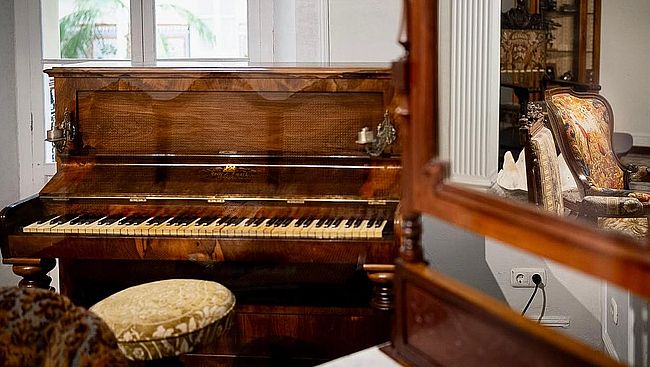Exhibitions
Temporary exhibitions are normally located at the ground floor of Casa del Administrador. Sometimes they move to the garden or the Casa Palacio.
La Concepcion houses a permanent exhibition at the Casita del Jardinero. Some scenes of the origin of the garden are told with Barbie dolls dioramas.
January: Siobhan Riordan. "Edén expresionista". Painting
February: Joaquín Cardalliaguet. "Amalia Heredia y el jardín". Mixta
March: Vicente Denis Corrales. "Los logros de Hércules. Los enemigos, las víctimas y los vencidos". Acílico
April: Jeaninne Cook. "De Mallorca a Málaga, Trazando la Naturaleza en Plata".
May:Alexander von Humboldt y los orígenes de la Ecología.
Jun: Catalina Coronado Guerrero. "Emboscados". Mixta; acrílico, acuarela.
July: Selection of participants in the painting. Asc. Friends.
August: Selection of participants in the painting and photography contest
September: Jocelyn Marmottan. Jardín Habitado, in Natura.
October: Gill Eardley. Ilustraciones botánicas del jardín.
November: Colectiva. Movimiento Hyde. El Jardín ocurrente.
December: Fernando Luque Cuesta. Naturaleza en grabados.
Naturaleza en grabados, Fernando Luque Cuesta
December 7, 2025 to January 11, 2026
In this exhibition, Fernando does not forget his artistic exploration and commitment to rural and natural memory; therefore, his engravings of this Garden and his scenes of horses in motion dialogue as two ways of understanding life. In the former, nature is shown as a body that holds memory: vegetation that grows and remains, inviting slow contemplation. In the latter, the horse bursts forth as energy and movement, tracing an ancestral choreography across the landscape, a link between nature and humans, between freedom and territory. Together, both series propose thinking of nature not as a setting, but as a presence that accompanies us and reminds us that art retains what is observed with sensitivity and care, precisely what we must bring to our coexistence with nature. The exhibition is organized by the Association of Friends of La Concepción.
Fernando Luque Cuesta (Casabermeja, Málaga) develops his work from a deep connection with the rural environment, articulating his production around the relationship between Homo sapiens and nature. Trained in Fine Arts in Seville and with a Master's Degree in Drawing from the University of Granada, he participated as a scientific illustrator in the archaeological expedition of the Qubbet el Hawa project (Aswan, Egypt), an experience that enriched his view of the links between art, science, and material memory. His work, always attentive to rural and natural memory, unfolds in series such as Torcal, Cartujanas, and, more recently, Jardín. Paraíso botánico de La Concepción. He currently teaches at the Faculty of Fine Arts in Granada.
The history of La Concepción told by Barbie
The idea of using dolls to recreate the garden's history was conceived by the artist Alberto Martin, who has been putting together displays with Barbie dolls for many years. After studying a number of late 19th-century photographs, mostly from the Silvela Legacy, he created a series of almost identical scenes using not only the world-famous Barbie but also Ken, Madelman and other similar figures. Sponsored by the Malaga Foundation and the Friends of La Concepcion Association.
The aim of this exhibition is to portray both a key period in the history of La Concepcion and the Bourgeois lifestyle of the time in a way that will appeal to visitors of all ages. All of the materials used in the displays have been recycled: bottle tops, sink racks, clothes pegs, pencil sharpeners, pin cushions etc. Each figure is dressed in a different costume and hat made from dressmakers' cuttings; the hairstyles, fans and parasols sported by the women are all unique and were inspired by 19th-century clothing catalogues.
Furniture of the old library of the Stately Home
This exhibition displays period furniture in the room that housed the library of the Casa Palacio in the 19th century. The room can be accessed through a methacrylate tunnel to prevent deterioration of the furniture. This is intended to enhance the value of the elements of this space, which has allowed not only to improve its preservation, but also to generate greater artistic and cultural interest among visitors. Most of this furniture is part of the municipal heritage and dates from the second half of the nineteenth century and the first half of the twentieth century. Some of the most noteworthy are the office table of General Espartero, made of oak and of French origin, which served as Jorge Loring's own desk; as well as a mahogany chair that accompanies it. Another valuable element is an English Edward VI style mahogany corner cabinet with built-in bookshelves, display cabinet, table and sofa.



